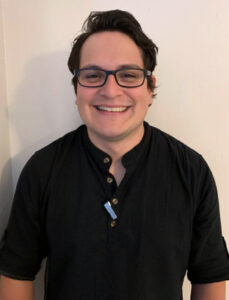MSE Graduate Student Discovers Career Path During Difficult Times
By Harrison Raskin
Third year MSE graduate student Marco Echeverria spent a second highly productive summer at the Lawrence Livermore National Laboratory (LLNL).
Echeverria says his research focused on using simulations to model the generation of metal ejecta from high-energy experiments with metals and lasers.
“The focus of the simulation effort is to provide an atomistic insight on the process, and to study the microstructural and defects effects on the ejecta formation. Results such as strength values, dominant dislocation types and free surface morphology can be then used in higher length-scale simulations, such as continuum mechanics, to fill the gaps these models have due to their larger scale”
LLNL physicist Alison Saunders, Echeverria’s internship supervisor, said that gaining a better understanding of ejecta interactions has a broad range of applications including spacecraft shielding, cold-spray welding, additive manufacturing and understanding material strength at small scales.
These findings will contribute to LLNL’s primary responsibilityof ensuring the safety, security and reliability of the United States’ nuclear deterrent. The research laboratory is focused on using applied scientific and engineering advancements to support breakthroughs in counterterrorism, nonproliferation, defense and intelligence, energy and environmental security; a few of the many ways in which work such as Echeverria’s can improve the world beyond the laboratory.
Echeverria likes that his work with LLNL is now a direct component to his PhD research. “My (PhD) work focuses on the behavior of materials under extreme environments, such as laser excited shock loading and piston loading. The ejecta studies with LLNL are another type of outcome in similarly extreme mechanical environments, so it all fits together well.” At UConn Echeverria works under the guidance and advice of MSE Associate Professor Avinash M. Dongare, principal investigator of the Dongare Computational Materials and Mechanics research group. Echeverria says that Professor Dongare recommended he attend the 2019 Stewardship Science Academic Programs (SSAP) conference in Albuquerque where he connected with scientists from LLNL. Marco’s graduate research at UConn is part of the Center for Research Excellence on Dynamically Deformed Solids (CREDDS) that is funded by the Department of Energy’s National Nuclear Security Administration (DOE/NNSA). Dongare notes, “One of the top priorities of CREDDS is the ability of the students to engage with NNSA labs.
Marco has been a success story for the center wherein he has worked with the scientists at LLNL to build a strong direction for his PhD research. This is truly impressive for a graduate student.”
Echeverria was one of millions of American students who found their academics restructured by COVID-19. Despite a shift to virtual research jeopardizing positions in most laboratories, Echeverria was able to obtain a completely remote internship.
Illustrative microstructure showing nucleated voids and ejecta jet, with a cloud breakout as the jet expands. The microstructure is colored based on particle velocity increments.
“My work is in molecular dynamics, so I can do that even if I only have a computer and internet connection. LLNL did an amazing job with all the interns, especially with the tech-support and being remote.”
The laboratory prioritized virtual communication by implementing weekly team meetings and daily interactions with mentors.
Returning to UConn this fall, Echeverria describes some difficulties with virtual research.
“It makes it a little complicated giving it 100 % while always staying in the same environment. Personally, I like to have a place of work and another of leisure. Now, after so many months, I’ve gotten used to having an agenda while working from home, although it is always hard not to take a nap after lunch!”
The positive internship experience also has Echeverria considering working within a national laboratory as a career option.
“I really like the close connection between experimental work and modeling that’s possible in a national lab research environment,” Echeverria said. “It’s exciting to be able to reverse-engineer simulation codes based on experimental results.”
Echeverria received his bachelor of engineering degree in mechatronics engineering from the Central American Technological University of Honduras in 2015, and his master’s degree in mechanical engineering from the University of Puerto Rico (Mayaguez) in 2018. Echeverria joined UConn in the fall of 2018 as a graduate student pursuing a PhD in the MSE department, and is currently the secretary of the UConn Materials Research Society Chapter. His research focuses on the atomic scale modeling of the deformation and failure response of multiphase metallic materials under shock loading conditions.
Published: October 5, 2020
Categories: graduate students, internship, news
Available Archives
